1867-1949
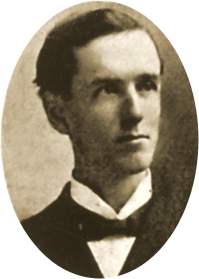
Ligon Portraiture, 1899
![]()
The Life Of L. S. White
L. S. White, GA Obit., Burton Coffman
L. S. White, GA Obit., Batsell Baxter
The Passing Of L. S. White, By C.M. Pullias
L. S. White, By Horace W. Busby
Directions & Grave Markers Of L. S. White
![]()
Lloyd Smith White was born April 11, 1867 at Bagdad near Gainesboro, Tennessee of Ransom R. and Harriet Clark White. He grew up on a farm and early learned the meaning of hard work, but his education was not neglected.
He attended the public schools available and later attended a college in Bowling Green, Kentucky for seven years. (We do not know the name of this school, but Potter Bible School was not begun there until 1901, so perhaps this was another school.) While in this school his closest college friend was a young man named Cordell Hull, who became the famous Secretary of State under President Franklin D. Roosevelt. This close personal friendship continued through out life.
He began teaching in early life and was in the class room either as a student or teacher until he was about twenty five, thus attaining a better than average education for his time. When he was five years old his parents obeyed the gospel, and he was brought up in a Christian home, and became obedient to The Faith when he was sixteen years old. On the day of his baptism he made a talk at the evening service and led the congregation in the singing of "A Charge To Keep I Have," evidently an expression of the faith already developed in his heart, for from the first he was determined to be a preacher of The Word. He soon preached his first sermon at a place called Cub Creek, evidently near his home. He soon developed and preached a series of sermons on the subject: "Behold I stand at the Door and Knock."
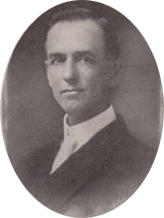
On February 12, 1891 he was married to Miss Florence Beck at Gainesboro, Tennessee by N.B. Young. Four children here born to them. They were: Wilbur, who became a gospel preacher, but departed this life in 1974. Naomi (Parker); Joseph, who lives in the Los Angeles, California area (1977), and is in very poor health; and L. S. Jr. Joseph spent his life as a preacher of the Word and as a teacher. L. S., Jr., the youngest, served in the U.S. Navy in World War I and remained in the Navy until his retirement, when he went into business. He lives (1977) in New Jersey. Sister Parker lives in Dallas and is a member of the Walnut Hill church, where her son, Lloyd Smith Parker, serves as a deacon (1977).
In 1915 his companion was called home by The Lord after an illness of about eighteen weeks. Two years later, on the day he moved to Dallas, he was married to Miss Dora Jones, a teacher and a faithful worker in The Church. *She is now (1977) ninety-four years old and lives in Hill Top Haven in Gunter, Texas. Two children, Ruth Smith, and Wren Campbell were born to them.
At the time of his first marriage he bought a farm and operated it for some years, for most gospel preachers had to provide their own support. In July, 1893 he began to devote full time to his preaching. He spent seven years in meeting work and then moved to Gallatin, Tennessee to provide better educational opportunities for his children, and to have better access to railway accommodations for his traveling.
In Gallatin the brethren prevailed upon him to preach for them, and so he began his first "local work." (Not many preachers were doing this at that time.) He continued with the Gallatin church for seven years, often holding meetings for other congregations all through this time.
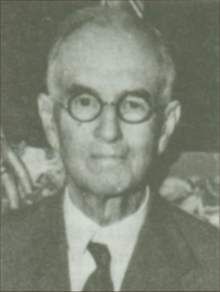
From Gallatin, he moved to Dallas, Texas where he worked with the Pearl and Bryan Street church for some years. He continued to hold many meetings, including some "tent meetings" in Dallas. The "tent meetings" resulted in the establishment of a congregation on Garrett Avenue, which is now the Skillman Avenue church, and a congregation in Oak Cliff, which later became known as the Kimball Square church.
From Dallas he moved back to Tennessee, locating at Columbia, but the climate did not agree with his wife's health and they returned to Texas. For some years he preached for The Church in Sherman, and while there a new building was built and paid for by the time it was completed. He also preached for the Tenth and Broad St. church in Wichita Falls, and while there preached over the radio, this being one of the first of our preachers to do such work. He also did local work in Waxahachie and finally with the Vickery Blvd. church in Ft. Worth.
In addition to his preaching, he was always busy in related work. He engaged in eighteen public debates, the most famous of which was his debate with Charles T. Russell, founder of the Jehovah Witness sect. That book is still in print and shows the inherent weakness of the false teaching in this system, much of which is still taught by his followers.
He published several books, including a book of sermons on Revelation, "Radio sermons on the book of Matthew." He also wrote two pamphlets on the subject, "Heaven is a Prepared Place for a Prepared People." For more than fifty years he faithfully preached The Word, baptizing more than eight thousand people. He performed hundreds of wedding ceremonies, and conducted about a thousand funerals. For a time he served on the Editorial staff of the Gospel Guide, a paper published in Dallas by the lamented Joe S. Warlick. He served as a lecturer for special lectureships at Abilene Christian University and Pepperdine University.
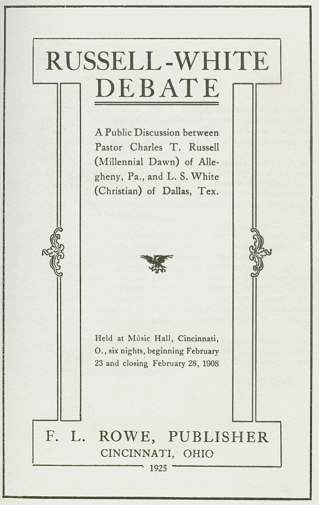
The Russell-White debate was held in the Music Hall in Cincinnati, Ohio from February 23 to February 28th, 1908. It was the result of correspondence covering nearly eight months between Russell and F.L. Rowe, editor of the Christian Leader. Brother Rowe writes regarding these matters: "In June, 1907, Mr. Russell wrote to me that if I would find a fair, honorable, straightforward servant of truth, and a representative man properly endorsed, he would meet him in public debate." Continuing, Brother Rowe said: "I immediately took the matter up with M.C. Kurfees and R. H. Boll, of Louisville, Kentucky, and they made selection of L. S. White, of the Pearl and Bryan Street Church of Christ in Dallas, Texas. The two were introduced by correspondence and within two months had settled the matters of subjects to be debated, rules, etc."
It was decided to discuss six questions, giving one night to the discussion of each question. Brother White wanted more time on each discussion, but to this Russell would not agree. He also requested that the disputants be governed by the rules laid down in Hedges Logic and that each debater be confined to the proposition under discussion. Russell refused to agree to this. He also refused to agree to have moderators who would be obligated to see that each debater observed the rules, demanding that there would be only a chairman who would preside over the debate and that there be a different chairman each evening. Russell insisted that: "...each speaker be allowed full liberty to order his subject according to his best judgment, and it shall be in order for him to present his arguments as may please him best." Brother White was not happy with these arrangements, but accepted them since there was no other way to have the debate.
During the debate Russell often paid no attention whatever to the arguments made by Brother White, and some of the time even wrote his negative speeches ahead of time, when he could not have possibly known what the affirmative would offer. Brother White mentioned in his first speech the second evening that he felt the Cincinnati Enquirer had not properly represented the debate. He also invited Russell to repeat the debate in some other places, including the home city of each disputant. Russell did not see fit to do this!
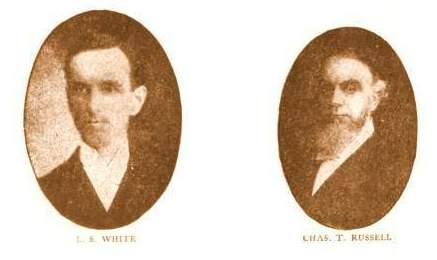
1908 Debate L. S. White vs. Charles T. Russell
In his first speech of the last night of the debate Brother White called attention to the fact that those who "... refuse to follow the inventions of man's wisdom in the work and worship of God's people... have to fight for those principles and contend earnestly for every inch of ground gained. In most instances against the combined opposition of sectarianism in all its forms." He then called attention to the fact that "... the Christian preachers of Cincinnati, Covington, and Newport, who use organs and manmade societies in the service of God, rushed into the secular papers just before the debate with the following resolutions published to the world:" He then quoted the resolution in which they repudiated Brother White, saying he was: "Unknown to any of us, either personally or by reputation." They continued: "We are now informed that he belongs to a small 'anti-wing' of The Church and in no way represents the great brotherhood of which we are a part." They continued: "...the questions to be affirmed by Mr. White are not peculiar tenets of the Christian church, (see note below) and upon most of these questions, as in nearly every religious body, there is no unanimity of belief among the disciples." (Note: The propositions Brother White affirmed were: "1. The Scriptures clearly teach that all hope of salvation today, is dependent upon accepting the Gospel of Christ as revealed in the Scriptures, and that such acceptance is confined to this life." 3. "The scriptures clearly teach that the punishment of the (finally incorrigible) wicked will consist of conscious, painful suffering, eternal in duration." 5. "The scriptures teach clearly that immersion in water 'in the name of the Father, and of the Son, and of the Holy Spirit' for the believing penitent is for, or in order to, the remission of sins.") JUST THINK OF IT! In 1908 the Christian church had abandoned these fundamentals. No wonder our brethren would not and could not fellowship them!
The resolution continued in this vein and finally said: "We deplore the proposed discussion of some of the subjects named. We feel that the whole undertaking will prove barren of any permanent results that could be termed beneficial." Brother White said: "This presents a strange inconsistency; when the Christian church wants to appear before the world with great numbers, it counts me and all other preachers who stand with me, among its preachers, and even prints our names in its "year book;" but when we come into their midst to contend for the simple truth of the New Testament they repudiate us, and publish their repudiation to the world." He then called attention to the fact that one Christian church preacher, J. L. Hill, of the Central Christian church in Cincinnati, did not go along with them, and managed to get some other resolutions passed, "but they have never been given to the public, and I know not what they are."
Continuing, he said: "It is also a significant fact that the Christian Standard of this city, and one of the most largely circulated papers in the Christian church, has never in any way lent its influence to the debate, except to refer to it once in a four-line statement several weeks ago, notwithstanding the fact that a copy of the propositions and a personal letter were sent to that paper."
Brother White suffered a stroke while preaching in Ft. Worth in 1945 and was unable to preach any more. He lived for about four more years, until eleven twenty on the Lord's Day morning, while the saints were assembled for worship, February 28, 1949 he slipped away into the better land. What was mortal sleeps in the Rose Hill cemetery in Ft. Worth.
He was a great and good man and gospel preacher. He was a builder of The Kingdom, and left a family worthy of himself. May God bless them all.
-Loyd L. Smith, Gospel Preachers Of Yesteryear, c. 1988, pages. 391-395; Originally Published In The Christian Worker, June, 1977. Note: This is a timed piece. Some of those enlisted as living may be now deceased.*Sister Dora Jones White passed away in 1979, and is buried next to her husband. See grave below.
![]()
Funeral Services For L. S. White
Funeral services for L. S. White were held at Fort Worth, Texas, Wednesday, March 2, in the Polytechnic Church. His death marks the end of an amazingly successful career as an evangelist of the everlasting gospel. Brother Whites, along with Jesse P. Sewell, was a pioneer in the phase of the work generally called the "local ministry." In fact, when Brother White was the full-time minister of the church at Gallatin, Tennessee, about 1900, there were few, if any, other men in the church doing similar work. A.C. Pullias, president of David Lipscomb College, stated at the Abilene Christian College lectureship last week that Brother White and Brother Sewell were the only two thus employed at that time. Needless to say, that type of work, being news, was criticized. Brother White vas the object of widespread opposition which centered on what some called the "pastor system." However, time has vindicated his soundness and his vision. He lived to see the work he pioneered universally accepted in the church. Moreover, he enjoyed many fruitful and happy ministries himself. He contributed richly to the building of such churches as Pearl and Bryan (Dallas), Tenth-and Broad (Wichita Falls), Walnut Street (Sherman), Vickery Boulevard (Fort Worth), and the Waxahachie Church. He was also widely used as an evangelist.
It was my privilege to begin my ministry in the church as an associate and song director for Brother White when we were both serving the Tenth and Austin Streets Church, in Wichita Falls. I honor his memory. He was a true Christian, a great church builder, a natural leader of men. and a loyal friend.
A son of Brother White's, Wilbur H., is the minister of the West University Church in Houston. The church extends warmest sympathy to the entire family of the deceased. Several from Central attended the funeral.
Men are often known for slogans they frequently used. One of Brother White's favorite expressions was: "Brethren, we are growingl" May there be other men to take up that cry as the church moves forward on the world front.
-Burton Coffman, Gospel Advocate, Volume XCI(91), No. 21; May 26, 1949, page 333.
Note: This is a timed piece. Some of those enlisted as living may be now deceased.
![]()
Just recently I learned from Texas of the passing of L. S. White. He has been faithful soldier of the cross for a long time.
My first acquaintance with Brother White was in my students days. I bought a copy of the "Russell-White Debate." In this debate Brother White thoroughly overturned the millennial-dawn doctrine of Pastor Russell.
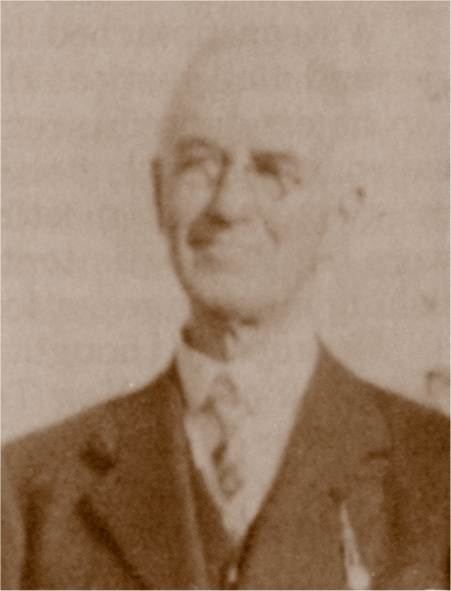 My next contact with Brother White was when he moved from Tennessee to Texas. I heard him in a meeting in my home town, Sherman. The way he handled his Bible was a marvel to all of us. He used more Scriptures in his sermons than most preachers;
and read every one from his Bible without any interruption of the sermon. He knew his Bible.
My next contact with Brother White was when he moved from Tennessee to Texas. I heard him in a meeting in my home town, Sherman. The way he handled his Bible was a marvel to all of us. He used more Scriptures in his sermons than most preachers;
and read every one from his Bible without any interruption of the sermon. He knew his Bible.
Brother White stayed a long time with the Pearl and Bryan Streets Church, of Dallas, Texas, and was an inspiration to the work there and a helpful companion to the preaching brethren in that section of the country. His work in Sherman was also outstanding. During the twelve years he was there the brethren built a new church house which cost $75,000. This was a huge sum for those days. Every dollar was paid before the first meeting in the church and the first meeting came as soon as the church was completed.
Brother White was one of the best personal workers among our preachers, and the church grew and prospered
wherever he worked. He was a faithful soldier of the cross, and those of us who knew him hope to meet him on the other side.
-Batsell Baxter- Gospel Advocate, Volume XCI(91), No. 22; June 2, 1949, page 349,350
Note: This is a timed piece. Some of those enlisted as living may be now deceased.
![]()
The Passing of L. S. White
C. M. PULLIAS
The passing of L. S. White is a source of sadness to me, and no, doubt to thousands of his acquaintances and friends. I was baptized at the hands of Brother White, and he performed our marriage ceremony. I was with him, after I obeyed the gospel, constantly for several years. He meant more to me than any. preacher in those days. He lent me much encouragement and helped me in many ways, for which I have always, been grateful. He was a good gospel preacher, and did much good. He was instrumental in leading thousands of souls to Christ. His labors are over now, and his works do follow him. He was a Christian and a gentleman. He leaves a good family behind, and some of them faithful gospel preachers. It was due to his influence that I was persuaded to preach my first sermon. In those early days of my Christian life he, was my helper and sympathizer. He was constantly in debates with the various denominational preachers, principally Baptists, Methodists, and Adventists. In these I was his moderator-as I remember, some sixteen to twenty of these debates in various sections of the country and in different states. In all of these he did some outstanding work for the Lord that has lived and will live on and on. But his work is done now. He lived a little more than eighty years. He suffered a stroke a few years before his passing, which incapacitated him for further preaching duties.
However, he was not dissatisfied with his lot, and apparently was contented with "godliness and contentment," which is great gain. It was my pleasure to visit him two years ago in his home in Fort Worth, Texas, and enjoyed a short time with him. I had a most encouraging letter from him at a later date. I had sent him a complimentary copy of my book, "The Life and Works of Charles Mitchell Pullias," which he had read through. I am glad that he could live long enough to read the book, because it was some of his labors which had ripened through the years. It does anyone good to see some of the works he has done mature before he dies.
But now his work is done. "Before are the grand reunions, behind are the sorrow and tears." "Dust thou art, and unto dust shalt thou return," is the great law which applies to us all. From it there is no appeal. The Bible tells us that when the dust returns to the dust the spirit goes to God who gave it. What he does with us then will depend upon what we have done with him while we lived. The body will grow old and feeble and finally die: but the spirit never dies nor grows old. Let us remember that it is appointed unto men once to die, and after death the judgment. None of us, perhaps want to pass through the dark passage of death, though it leads to the paradise of God. We are living and hoping that some day, we shall meet those gone before in that land that is fairer than day. May the precious memories of father and husband ever encourage you to live closer to one another and closer to God; and when your work is done, you can go to meet those gone before and live in that home of the soul forever.
-C.M. Pullias, Gospel Advocate, Volume XCI(91), No. 27, page 428.
Note: This is a timed piece. Some of those enlisted as living may be now deceased.
L. S. White
Loyd Smith White, a native of Tennessee, fell asleep Sunday morning February 27 at 11:20 in Fort Worth, Texas, at the ripe age of eighty-one years, ten months and sixteen days. Br other White had preached the gospel of his Lord for more than fifty years; baptized more than eight thousand persons, performed more than fifteen hundred marriages, conducted one thousand funerals and held gospel meetings from Maine to California, with many in Texas and Tennessee. He began public life teaching in the schools of Tennessee. He was baptized at the age of seventeen, in Gallatin, Tennessee, and made a short talk that day and sang a song at that service: "A Charge to Keep I Have." Not long after, he delivered a series of sermons on "Behold I Stand at the Door and Knock."
He began local work with the Pearl and Bryan church in Dallas in 1906. Spent forty-five years in local work with the churches in Dallas, Sherman, Wichita Falls, Waxahachie, and Vickery Boulevard in Fort Worth, Texas, with two years in Columbia, Tennessee. Nearly fourteen years in Wichita Falls, and eleven in Dallas and a number in Sherman, perhaps seven years. These records of regular work show how his work was appreciated by the brethren.
Many years ago, he held a noted debate with Charles T. Russell, of Cincinnati. He was an able speaker, diplomatic, kind and thorough in his teaching. It was the privilege of the writer to be associated with Brother White in about seventeen gospel meetings, about fourteen of these with the Tenth and Austin congregation in Wichita Falls.
It was my duty also, to deliver the address at his funeral service, which was held in the Polytechnic church building in Fort Worth. In this service, brethren LeRoy Brownlow, E . W. McMillan, Burton Coffman, Thomas M. Campbell and a group of good singers had a part. He was laid to rest in Rose Hill Burial Park, to await the call to judgment.
Brother White's first marriage was to Miss Florence Beck, of Tennessee. To them were born three sons and a daughter: Wilbur H. of Houston, one of our fine preachers, Joe W. of Santa Monica, California, a faithful teacher and gospel preacher, Loyd S. Jr., of Philadelphia, in the service of the U.S. Government, and Naomi, Mrs. J.P. Parker, of Handley, Texas. Sister White, the mother of these children died in Dallas, Texas, in 1915.
In 1917 Brother White and Miss Dora Jones, of Dallas, were married and to this union two daughters were born, Ruth Iris, now Mrs. Hollis Smith of Fort Worth and Wren, now Mrs. George Campbell of Los Angeles, California.
He also leaves one sister—Mrs. Rosa Hufhines of Carthage, Tennessee- and twelve grandchildren and six great-grandchildren. Many church leaders are among those baptized by Brother White, such as C. M. Pullias, and his brother who is the father of Athens Clay Pullias and his brothers. Also Foy E. Wallace, Jr., and too many more to mention here.
May God's blessings rest upon this noble family as I they carry on the name of this our dear brother in the work.
Horace W. Busby, Firm Foundation, March 22, 1949, page 3. Note: This is a timed piece. Some of those enlisted as living may be now deceased.
![]()
Directions To The Grave Of L. S. White
L. S. White is buried in the Shannon Rose Hill Memorial Park, Fort Worth, Texas. He was buried in Eastlawn (Section 8) Lot 290 Space 4. To find Shannon Rose Hill in Ft. Worth, Texas take the 820 Loop S. to Lancaster Rd. If traveling from the north go east (left) about two or three miles and the Rose Hill Funeral Home and Cemetery will be on the left. Go past the funeral home and first entrance and enter the cemetery at the last entrance on the left. As you enter the cemetery pull over to the curve on your right, and the White family plot will be right next to the drive. Note: While At Shannon Rose Hill be sure to visit the grave of Claude McClung.
GPS Coordinates
32.729127, -97.199275
Grave Facing West
Accuracy to 16ft.
Lot 290 Space 4
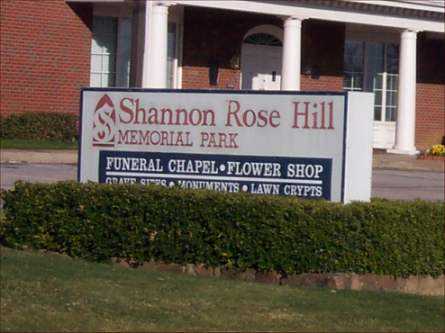
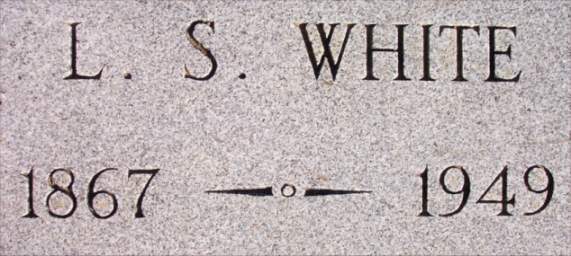
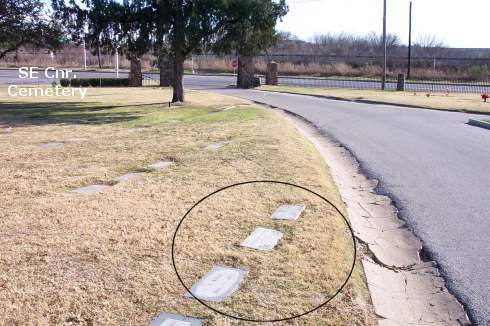
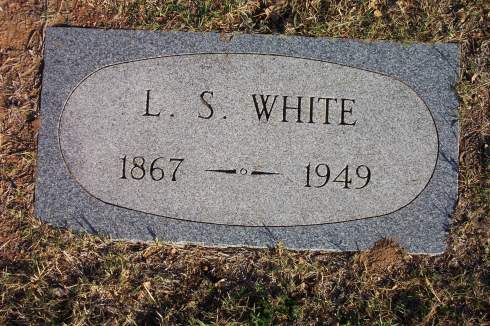
L. S. White
1867-1949
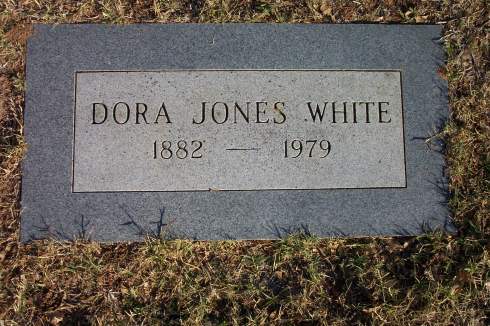
Dora Jones White
1882-1979
![]()
A Side Note . . .
Note: While in Shannon Rose Hill you may be interested in visiting the
grave of Lee Harvey Oswald. Though slightly related to the 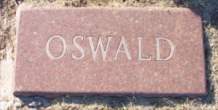 Restoration Movement through his wife, Marina, who was reported to have been baptized by a preacher in the church of Christ,
Oswald played a major role in U.S. History as the accused assassin of
President John F. Kennedy. He is buried on the west side of the cemetery
in section 17. The simple pink granite stone only says,
"OSWALD." The location of the grave is not generally publicized,
but I found the directions on the web myself. When I visited the grave in
January, 2004, I had hardly got out of my car when one of the staff pulled
up in a big black car and asked if they could assist me. They didn't seem
too pleased that I was in the area. So, they watch the grave pretty close. GPS Location: 32.732416,-97.203228.
Restoration Movement through his wife, Marina, who was reported to have been baptized by a preacher in the church of Christ,
Oswald played a major role in U.S. History as the accused assassin of
President John F. Kennedy. He is buried on the west side of the cemetery
in section 17. The simple pink granite stone only says,
"OSWALD." The location of the grave is not generally publicized,
but I found the directions on the web myself. When I visited the grave in
January, 2004, I had hardly got out of my car when one of the staff pulled
up in a big black car and asked if they could assist me. They didn't seem
too pleased that I was in the area. So, they watch the grave pretty close. GPS Location: 32.732416,-97.203228.
![]()